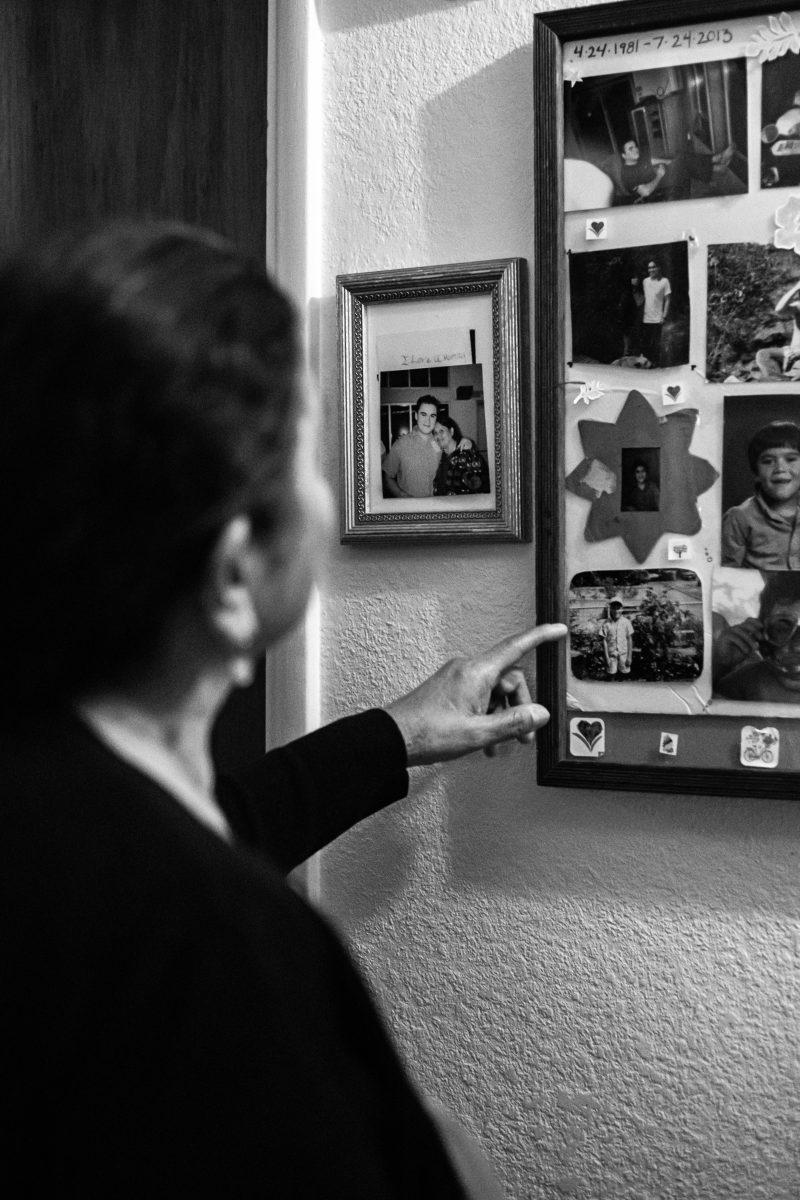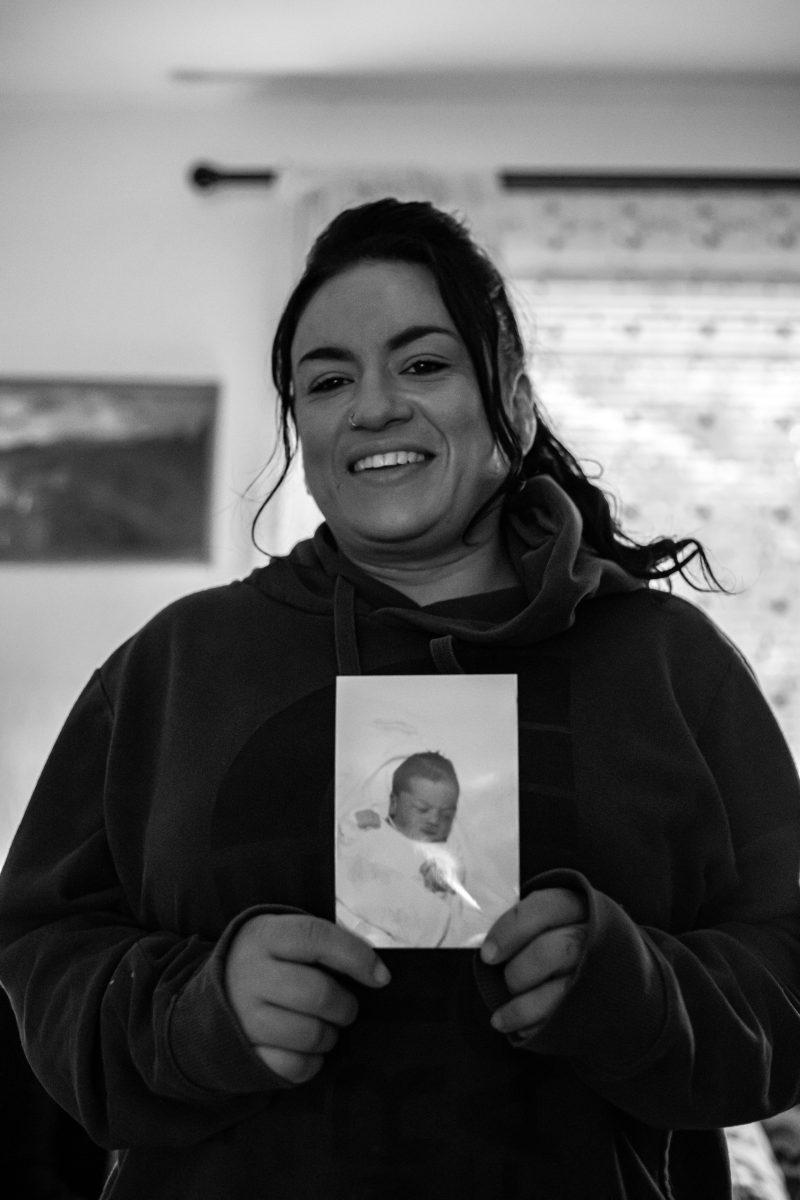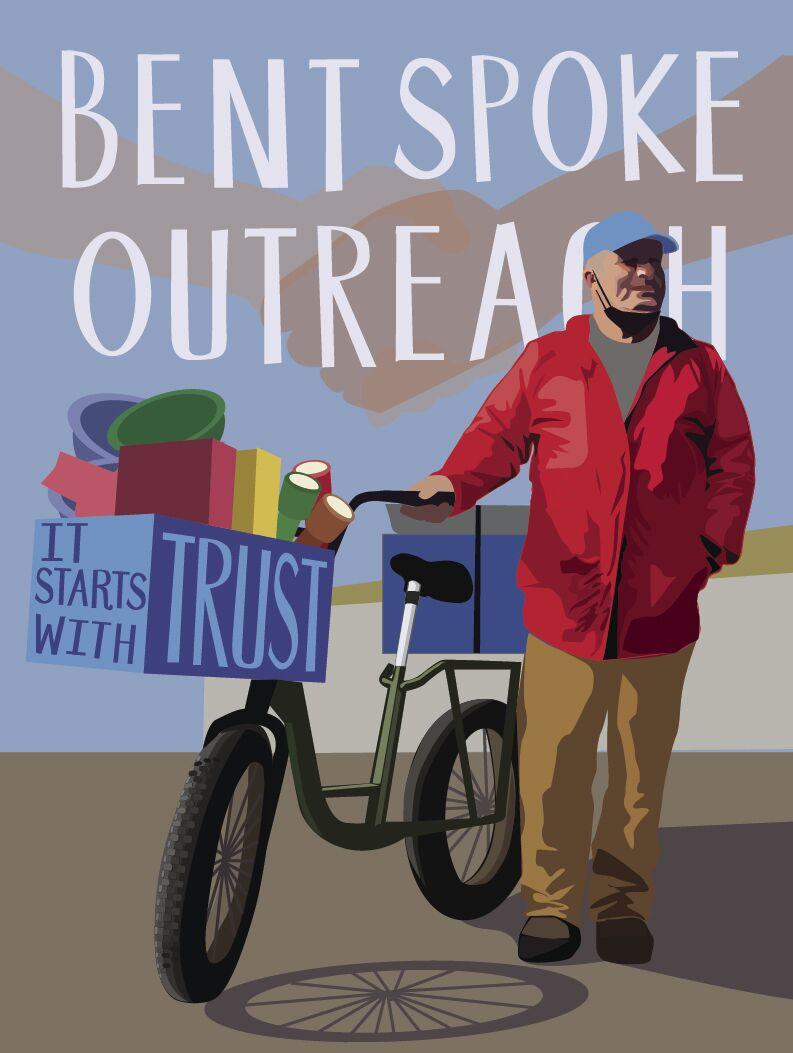In the back room of Dot Dotson’s is a row of filing cabinets filled to the brim with the negatives of thousands of babies born at Sacred Heart from 1950-2000. Annette Pfautz, long-time Dot Dotson’s employee, sifts through the negatives, pointing out some of her favorite photos as if she’s looking through photo albums of her own.
“Some of them are so sweet and smiling, and others you can tell had a rough time posing for their picture,” Pfautz says as she shows me a roll of one of the more photogenic babies.
Nestled in the heart of downtown, Dot Dotson’s is the oldest film and camera store in Eugene. For nearly 100 years, photographers, students and film enthusiasts have come to Dot Dotsons for their film needs. But behind the friendly staff and collectors’ cameras is Dot Dotson’s best-kept secret.
Over 20 years ago, Sacred Heart Hospital asked Dot Dotson’s if they would like to keep the boxes upon boxes of undeveloped rolls of film from the maternity unit. Dot Dotson’s accepted but didn’t have a plan for how to use them. The negatives sat in the store’s attic, collecting dust for 20 years until one of Pfautz’s friends inquired about the negatives.
“My friend asked me if I could check and see if her family member’s baby photos were in one of our files,” Pfautz said. “So I found the photos and developed them for her.”
Pfautz’s friends’ touching reaction to seeing the baby photos propelled her to stop hiding these photos from the public.
On Nov. 9, 2021, Pfautz created a post on Dot Dotson’s Facebook page explaining that the store had been sitting on these photos from Sacred Heart Hospital for over 20 years and was ready to give them back to their rightful owners.
“I posted it, and the next day I saw we had a couple of thousand views, and I was like ‘Wow, this is huge.’ And then three days later, we had 56,000 views,” Pfautz says. “I haven’t even checked in a while, but last I saw, we had around 80,000 views.”
The overnight success left Pfautz with a project bigger than she could have ever imagined. Phones began ringing off the hook, email inboxes became flooded and Pfautz scrambled to place all the photo orders in a timely manner.
“A lot of people who have called in or emailed said they couldn’t afford the pictures at the time or they lost the pictures in a fire,” Pfautz said. “I had no idea it would be so emotional for people.”
The rolls of film are light, but there’s an emotional weight to holding someone’s first photo ever taken.
TERRY EVANS
Terry Evans was born in 1973 at Sacred Heart Hospital and, until recently, had only seen one black and white photo of himself as a baby.
“The only photo I had of myself was in my crib, a dresser drawer, that they pulled out and pushed back at bedtime,” Evans says. “After my mom passed away, even that photo disappeared on us, and I had no baby photos whatsoever.”
When Evans was a kid, a flood ravaged through the double-wide trailer his family rented out and ruined dozens of family photo albums, including all Evans’ baby pictures. His wife, Amber, recalls only three childhood photos she’s seen of him.
Growing up, Evans’ family never had much money, and after his parents divorced when he was in middle school, their financial situation was put under strain. Evans and his mom moved in with his grandparents.
“Back then we were too poor to pay attention to what we had lost,” Evans says.
When Amber saw Dot Dotson’s Facebook post, she immediately reached out. She hoped that the photo, an artifact of Terry’s childhood, could be brought home. Amber was brought to tears seeing these childhood photos of her husband. Evans was happy to be reunited with childhood photos.
“Seeing those photos for the first time was amazing,” Evans says. “We compared it to our daughter’s baby pictures, and it was like the same picture, except she was happier.”
Evans described his younger self as “dumb and daring.” When he was 21 years old, he decided to join the army.
“He jumped out of helicopters, airplanes,” Amber says.
He served in the army for 22 years before deciding to retire from the nomad lifestyle of a soldier.
Evans found the three photos of him as a newborn to be a good indicator of the kind of person he’d grow up to be.
“The first photo’s angry, the other ones like ‘yeah I’m here,’ and the last photo is like I’m looking for trouble to get into,” Evans says.
His wife Amber chimes in: “Those photos kind of describe your life.”
HELEN TENDICK
Helen Tendick recalls the day she became a mother as the greatest moment of her life.
Tendick had her first baby when she was 20 years old. She was single and desperate to leave her small town in Wisconsin. Two years later, she packed up her life in a suitcase and hopped on a train to Eugene, Oregon — just her and her baby, Andrea. Five years later, her second daughter Kacinda was born, a year after that her son Nicholaus and five more years after that came her final daughter Rebecca.
“All I wanted was to have my babies and hold them and love them,” Tendick says.
Both Kacinda and Nicholaus were born at Sacred Heart Hospital, but Tendick couldn’t afford the hospital photos. Seeking more space and a closer community for her kids to grow up in, the Tendick family moved to a small town in Washington shortly after Nicholaus was born.
“I loved that neighborhood,” Tendick says. “We were all very close. I never had to worry about my kids.” She said her house was a hub for all the neighborhood kids. In return, she used her friend’s barn as a storage unit for all of her photo albums.
One morning she got a call from her friend that hogs had snuck into the barn and destroyed all the photo albums.
“I couldn’t salvage anything,” Tendick says.
The devastation of losing these photos was immeasurable to Tendick, especially after her son Nicholaus unexpectedly passed away at 32 years old. When Tendick found out that Dot Dotson’s had her and her brother’s baby photos, she couldn’t contain her joy.
“Nick left behind two sons who look just like him,” Tendick says. “I can’t wait to show them this photo of him.”
She smiled as she carefully pulled the photos out of an envelope. “I keep the photos with me on my nightstand so I can see them every morning when I wake up,” Tendick said.
It’s been decades since those photos were taken. Tendick is now a great-grandmother to 10 great-grandkids and a grandmother to 12 grandkids. Kacinda is a grandmother now, too, and works weekends so she can care for her grandchildren five days a week. To say the Tendick family is close would be an understatement.
“I feel responsible for preserving the history in my family,” Tendick says. “I want to make sure my grandkids and great-grandkids know.”
Every year since Nicholaus’ death, the Tendick family has hosted a celebration of his life filled with dancing, storytelling, friends, family and a chili cookoff. Tendick has a collage of photos of Nicholaus from his teenage years that she brings to the celebration. She plans on finding a place in the collage for the baby photo.
“I want my kids and grandkids and great-grandkids to know that family is the most important thing,” Tendick says. “Your family will always be there for you.”
SHELBIE LITTY
Shelbie Litty would consider her dad to be her best friend, though she’s not sure he would know that.
“My husband laughs at our communication because we’re not heartfelt at all,” Litty says. “He’ll send a text message like once a year saying ‘I’m proud of you’ and I cry.”
Litty and her father Kevin may not be the most affectionate toward each other, but Litty cherishes their relationship more than anything.
Litty happened upon Dot Dotson’s Facebook post regarding the Sacred Heart baby photos randomly. After combing through who she could know that would want their baby photos back, she realized her dad could have been born at Sacred Heart Hospital. Litty called her dad, who confirmed he was born at Sacred Heart in 1960. Although Litty has seen photos from her dad’s childhood, the prospect of seeing a newborn photo of him was exciting.
“I have a son and he’s two and looks so much like my dad,” Litty says. “That was a big reason why I wanted to see the newborn photos.”
Kevin is “a man who chooses his words wisely” and didn’t have much of a reaction to the newborn photos of himself. Litty, however, felt that these photos were another way for her and her son to feel connected to him.
“I framed the photo of my dad and put it in my son’s room,” Litty said. “My dad is his favorite too.”
If there’s one thing that Kevin has taught Litty, it’s to always be there for your kids.
Litty played basketball from fourth grade through high school, and her team was terrible. Litty recalls winning maybe two to three games per season, but her dad was sitting on the sidelines at every single game.
“I remember him not being at one game because there was snow,” Litty said. “I had legitimately thought something happened to him.”
Litty and her husband Chris plan to coach their son’s basketball team when he’s old enough. She’s excited to see her dad reclaim his spot on the sidelines when her son is old enough to play.
“I know my dad will be watching every game,” Litty says.
Pfautz would estimate she’s done about 550 orders so far, but the project is far from finished. She has roughly 1,500 orders left to get through, and that number is only increasing.
“The project has really taken a life of its own,” Pfautz says.
Pfautz leads the way upstairs to the attic, where more file cabinets are filled to the brim with negatives. The negatives in the attic are the oldest photos dating back to 1950. As she’s sifting through more negatives, she finds some of people she knows personally.
“My husband asked me if I could find his coworker for him and look where he is,” Pfautz says.
Who knew that these rusted file cabinets sitting in the attic of a film store were the center of life in Eugene?
If Pfautz has any advice to give to those who still shoot on the film, it’s to keep the negatives.
“In the future, you never know what will come of them,” Pfautz says. “Whether it’s just memories that you had forgotten about, history comes back.”
In the corner of her house, Helen Tendick sits on the chair in front of her desk where she keeps photos of her children Kacinda and Nicholaus. Tendick received the photos from Dot Dotson’s after losing most of their family photos in a barn in Washington. Tendick always sets the photos on her desk so that she doesn’t lose them again.












![[Photo Courtesy of the Lara Family]
Ruben embraces his beloved childhood goat, Katrina.](https://ethos.dailyemerald.com/wp-content/uploads/2025/05/katrina-1-1060x1200.jpg)


